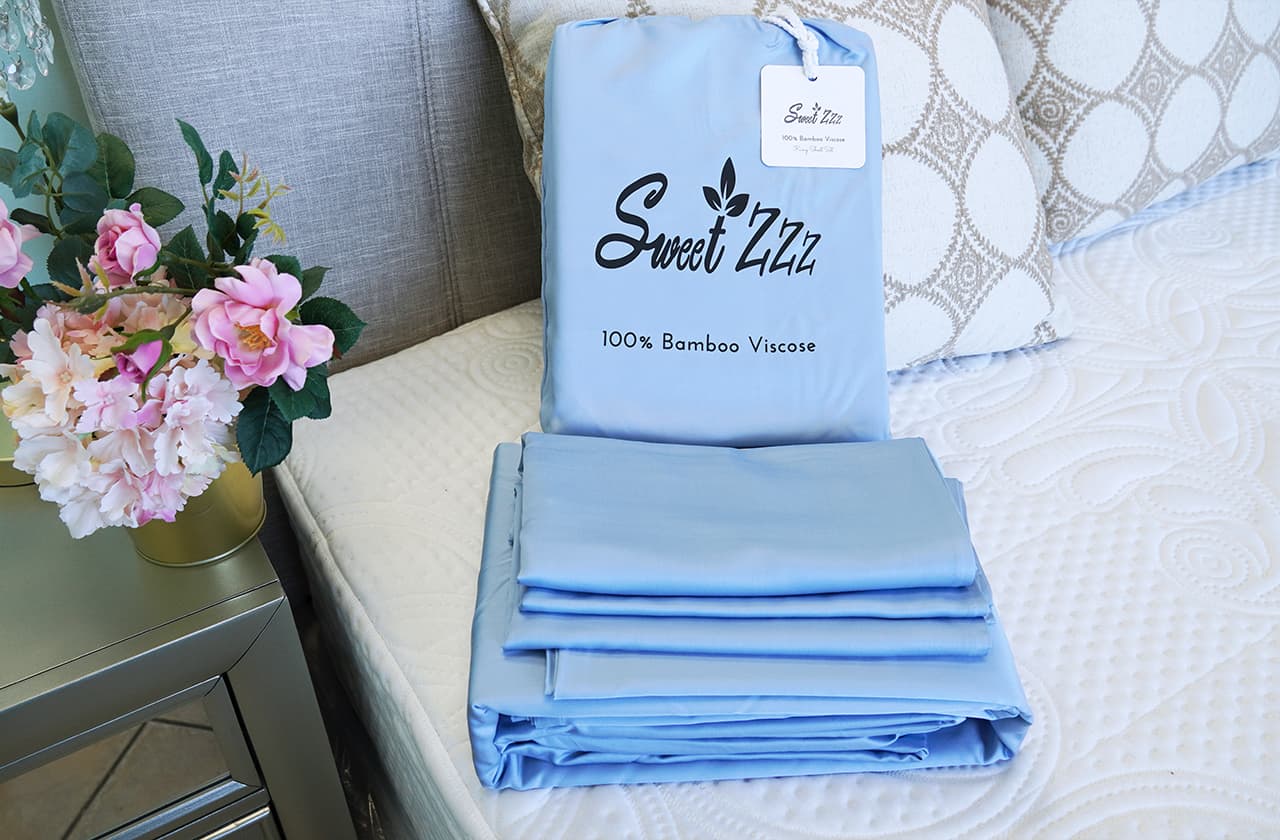It used to be that when you wanted sheets there were no other options other than cotton or polyester, however, Bamboo sheets have emerged in recent times and prove to be a softer, healthier, and more durable choice.
With so much talk about Bamboo, it’s okay to ask yourself what are bamboo sheets anyway?
That’s what this article aims to explain. We look at what bamboo sheets are, how they are made, different types of bamboos and their benefits. So, stick around to find out whether these are the sheets for you or not.
What are bamboo sheets?
Bamboo sheets are sheets derived from the fibers of the bamboo plant. The bamboo tree has been used for many applications including flooring, furniture, food, and even in fashion- as structural support in corsets.
However, considering the negatives of cotton farming or the use of synthetic materials such as polyester for bed sheets, manufacturers discovered an eco-friendlier and sustainable material to make beddings.
Bamboo is the material and it’s softer, stronger, and healthier than most other bedding materials. That’s great too because we spend a third of our lives sleeping.
But how is the tough bamboo wood turned into silky smooth sheets? That’s what we discuss in the next section.
Best Bamboo Sheets 2020
If you are interested in: Best Bamboo Sheets for 2020, then, here’s all you need to know to pick the perfect one.
How are bamboo sheets made?
There are two methods of making bamboo fiber. There is a mechanical or retting method and there is the chemical method.
Mechanical Process of Making Bamboo Sheets
The mechanical or retting method produces natural bamboo sheets that retain all of the benefits of the bamboo tree.
In this method, the stems of bamboo are mechanically crushed and treated with natural enzymes that help break down the wood pulp.
The resulting mixture is then dried and spun into yarn.
This method is used to make bamboo linen sheets. They are not the softest sheets and wrinkle quite a lot but they are also highly breathable, eco-friendly, and hypoallergenic.
Chemical Process of Making Bamboo Sheets
On the other hand, the chemical method has three generations of fiber, viscose or bamboo rayon is the first generation followed by modal and most recently, Lyocell.
Bamboo Rayon
The process of making bamboo rayon sheets begins with the harvesting of bamboo stocks. The bamboo plant is never harvested in its entirety instead the roots are left intact so that it can spring back to life.
The stems of the bamboo plant are then shredded and fed into a chemical solution that will dissolve the cellulose out of the wood.
Here is where the eco-friendliness of bamboo rayon sheets becomes questionable. However, some manufacturers use non-toxic chemicals such as sodium hydroxide to derive the cellulose.
Be on the lookout for such manufacturers when considering bamboo sheets because the majority of them are bamboo rayon sheets.
The cause of Bamboo’s eco-friendly dilemma?
Other manufacturers go an extra step of adding carbon disulfide or sulphuric acid to the cellulose extracting method.
This strips the bamboo sheets of all their benefits and makes them similar to synthetic rayon produced from other plants.
It also makes them less eco-friendly because of the chemical wastes and their effect.
If you love Bamboo for its eco-friendliness, you might want to avoid manufacturers that use this step.
In the end, bamboo viscose or rayon from bamboo is a super soft, strong, thermoregulating bed sheet to use on your bed.
On whether Bamboo Rayon is hypoallergenic, a study in India (2012) found that rayon from bamboo is effective against bacteria, meaning it still retains the antibacterial properties of its parent plant.
Modal
Modal is a regenerated cellulose fiber just like bamboo viscose or rayon. The same processing method is used with the addition that the filaments are made stronger and stretchier.
Modal is mostly used in the production of sports clothing. Its strong nature can withstand harsh treatment.
Lyocell
Lyocell is the third generation of regenerated cellulose fiber from Bamboo. It’s mostly traded under the brand name Tencel.
Lyocell is the eco-friendliest version of the bamboo fiber of the three.
It uses gentler chemicals in its production and its closed-loop production method ensures there is minimal waste. Most of the chemicals and water are recycled for reuse.
These are the methods used to produce bamboo sheets. The methods of production, though, only impact the benefits of bamboo sheets. If you want to distinguish bamboo sheets by their feel, then you should check it’s weaving method.
Bamboo Sheet Weaves
Bamboo is popular for its buttery-soft-silky finish. But what gives it that finish? That’s what we look at in this section.
The feel and finish of a bamboo sheet are partly determined by the weaving method applied.
There are two main weaving methods in bamboo sheets. Sateen and Twill weaves are these methods.
Sateen Weave
Sateen weave gives off the ultra-smooth silky finish that adds luxury to your bed. It entails weaving three strands over one pattern. Bamboo fibers are usually long and a single fiber can run the entire length of the sheet.
Unlike other sheeting materials that are made from shorter fibers weaved together, bamboo fibers are long and continuous, which gives the sheets the silky finish and lends to their durability.
Twill Weave
Twill weave produces a studier, soft but less silky finish than sateen weave.
It entails a diagonal weave pattern. This weave pattern is usually a bit more loose, which makes twill weaves more breathable and best for cooling purposes.
If you tend to sleep hot, you will want to consider bamboo sheets with a twill weave. Twill weave sheets also last longer than sateen because they are stronger.
Now that you know how the weaving method plays into the type of bamboo sheet. You should be able to comfortably choose the sheets that best suits your needs
Thread count
When it comes to choosing cotton sheets, thread count plays a big role. With bamboo sheets, however, thread count is not as important. Bamboo produces long continuous fibers that are strong and great for a silky soft finish.
A 250 thread count bamboo sheet is softer than most high thread count cotton sheets. No matter the thread count, bamboo sheets are likelier to be softer than most cotton sheets, some with up to 1000 thread count.
Chemical Process of Making Bamboo Sheets
Breathability
Among many of the bamboo sheet’s incredible benefits is its breathability. Since bamboo is a natural product, it’s sheets maintain an open cell structure that is great for airflow.
Bamboo sheets are thermoregulating in nature. They help you sleep cool when it’s hot and warm when it’s cold.
Bamboo also has a higher absorption rate than cotton. This makes it great at moisture-wicking, which helps you sleep cool all night long.
Softness
One major determinant for buying sheets is their comfort level. Bamboo is known to be softer than cotton. If you are looking for silky smooth sheets that help you drift off to sleep faster, then bamboo sheets are it.
The silky-smooth, long continuous bamboo fiber gives off a smooth luxurious finish that rivals even high-quality Egyptian cotton sheets.
Sustainability
Bamboo is known as the fastest-growing plant in the world. It grows up to 36 inches in a day.
It’s a good alternative to plants such as cotton which are labor extensive, use plenty of water, and pesticides in their farming.
Contrary to cotton, bamboo uses 200 times less water than cotton in its production. It grows fast and helps produce 35% of the world’s oxygen.
It can grow in arid areas with zero use of pesticides or fertilizers. Its ability to grow back after it’s harvested makes it a sustainable source.
Hypoallergenic
Bamboo in its natural form is pest and insect resistant. Some if not all of this property are transferred to the finished sheets.
It’s, therefore, a great option for people who suffer allergies as it keeps dust mites and other allergens away. It’s also mold and mildew resistant.
Durability
Bamboo’s strong continuous fibers are highly durable. Bamboo sheets can last up to 15 years which is two to three times longer than other sheeting materials.
Proper care, however, is needed to maintain these sheets. Ensure you read the manufacturer’s label and follow their instructions carefully.
Stain resistance
Stains make sheets rather unsightly. Luckily, sheets made from bamboo are to a great extent stain resistant.
The naturally dense bamboo fibers and their ability to release moisture into the air helps keep them from absorbing oils and other body fluids that could stain the sheets.
Over to you….
That is what bamboo sheets are. By now it should be clear that bamboo sheets which are derived from the fibers of the bamboo plant are softer, healthier, and stronger than most other sheets.
If you love to sleep green, then bamboo sheets are a great option. Their eco-friendliness and sustainability make them a great choice for the environment.
Though they come with a higher price tag, they are value for money. They last two to three times longer than cotton and other bedding materials.
If you sleep hot, bamboo sheets are the best remedy. Their breathability and exceptional moisture-wicking abilities make them the best cooling sheets available.
With that, we hope all your questions about bamboo sheets are answered. Happy shopping!!
We may receive a referral fee each time a consumer uses a link or code on this website to purchase a product with, for more info visit our disclosure page.


